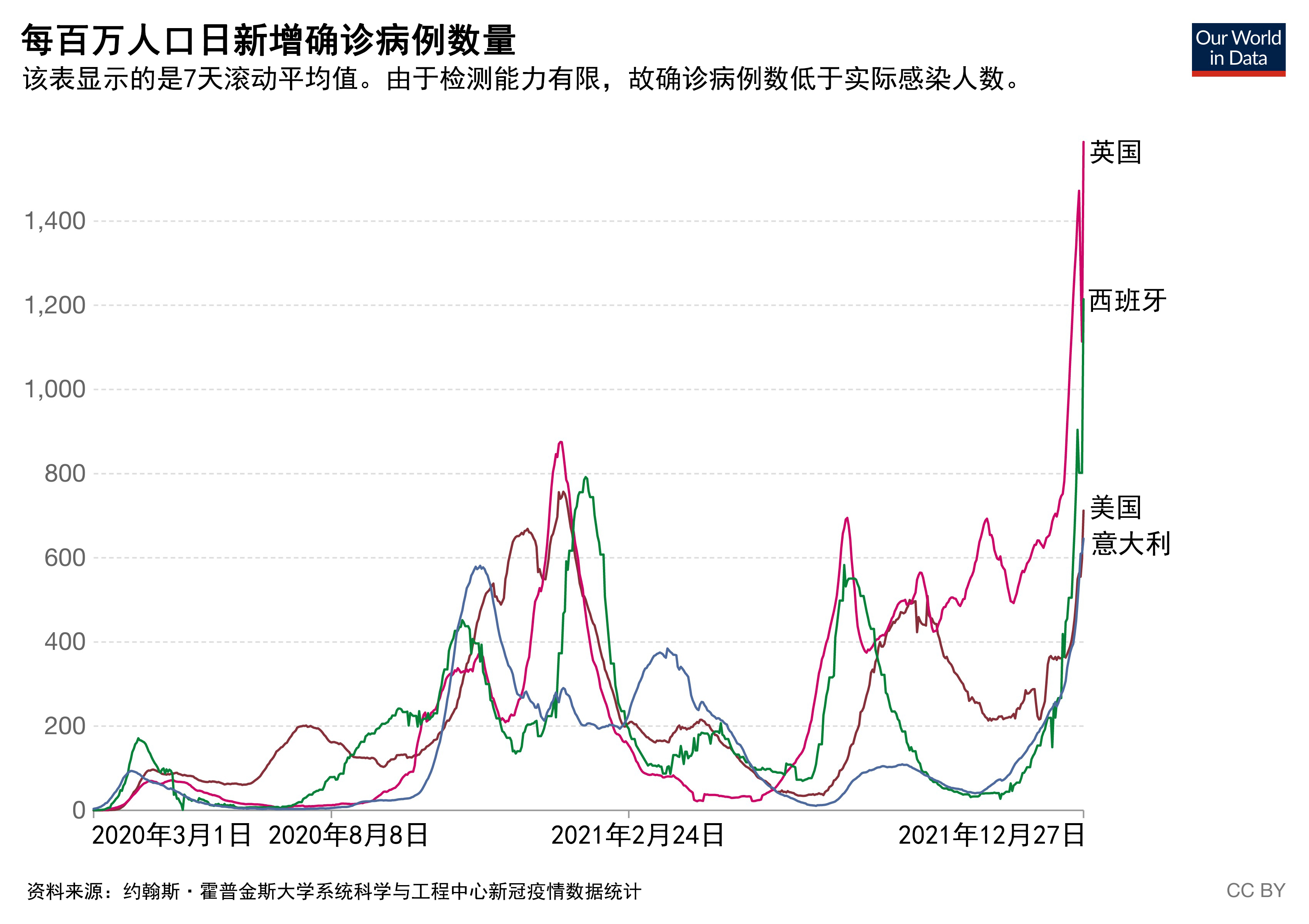奥密克戎变异毒株在多个国家疯狂肆虐,感染率达到了自新冠疫情爆发以来的最高点。2021年12月27日,全球新冠肺炎日新增确诊病例超过140万例,创历史新高。
多国政府已经收紧了防疫措施,重新实施更严格的社交距离限制,甚至重新进入封锁状态,比如荷兰,2021年12月中旬再次颁布了封锁令。但一些国家已经决定,采取置之不理的态度。这些地方的现行防疫措施比之前几波疫情时还要宽松。
以下几个国家都拒绝收紧防疫措施,让我们来看一看它们准备如何应对奥密克戎变异毒株。
英格兰
迄今为止,英格兰当局仍然拒绝重新严格实施保持社交距离的措施,例如,立法禁止6人以上的聚会,以及要求餐馆和酒吧只提供户外服务。然而,除英格兰外,英国本土的其他地区,威尔士、苏格兰和北爱尔兰,已经出台了新的防疫限制措施。威尔士要求剧院和电影院执行社交距离两米的规则,禁止举办体育赛事和其它大型聚会,并规定酒吧和餐馆只提供就座的餐饮服务。
实际上,英格兰甚至还实行了一项放松限制的措施:新冠肺炎确诊者可以通过核酸检测,将10天的自我隔离期缩短至7天。如果隔离第六天还没有任何症状出现,且第六天和第七天的快速核酸检测结果均为阴性,就能够提前结束隔离。
美国
其他国家也采取了类似的措施来放松防疫限制。美国疾控中心(Centers for Disease Control)发布了新的指导意见,将无症状者的自我隔离期缩短至5天,但该中心同时建议,隔离期结束后的5天内,如果有他人在场,也应该佩戴口罩。

美国疾控中心表示,根据不断演变的数据可知,从出现新冠症状前的一至两天到出现症状后三天这段时间内的传染性最强,而发布的防疫新规正是在此基础上制定的。在美国和英国,由于奥密克戎变异毒株飞速传播,大部分人被迫居家隔离,无法工作,因此出现了经济混乱现象,相关新规旨在对此进行抑制。美国的许多航空公司由于缺少机组人员,排班出现困难,而不得不取消航班。许多英国医务人员进行自我隔离,缺勤率升高,使本来已经极度紧张的国民医疗服务体系(National Health Service)雪上加霜。
欧洲
意大利政府担心现行自我隔离措施可能会导致国家经济瘫痪,所以表示正在考虑修改防疫规定。意大利现行防疫措施规定,密接者若已经接种疫苗,必须隔离7天;而未接种疫苗者,即使核酸检测呈阴性,并且没有任何症状,也要隔离10天。
其他欧洲国家的政府官员和卫生部门也在修改防疫策略,以应对奥密克戎变异毒株的袭击。
在西班牙,政府重新出台法律规定,要求人们在户外必须佩戴口罩,但也允许一些例外情况的存在。比如,当人们“在大自然环境中”,与同住的家人共处时,以及可以充分保持安全社交距离的情况下,无需佩戴口罩。当地时间2021年12月29日,西班牙政府的卫生委员会将决定是否仿效英美,缩短现为10天的自我隔离期。西班牙只有加泰罗尼亚一个地区选择再次收紧防疫措施,例如实施夜间宵禁、限制餐馆和其他室内场所的人流量等。
向现实低头
虽然奥密克戎是迄今为止最具传染性的新冠病毒变体,但南非等地的初步研究数据表明,感染奥密克戎导致的病症可能要比之前的病毒变体(比如德尔塔变异毒株)引发的症状轻。这就是面对更高传染力的奥密克戎变异毒株,各国政府反而放松防疫措施的科学依据。
此外,新冠疫情爆发早期,感染率和住院率呈紧密正相关。而现在,充分接种疫苗的人数增加,很多人打了加强针。因此,即使感染率升高,住院率也不一定会大幅增加。各国政府之所以决定实施封锁措施,严格要求保持安全社交距离,主要原因一直是害怕卫生保健系统不堪重负而崩溃。
然而,放松对奥密克戎变异毒株的防护措施,在某种程度上反映了经济上的必要性。如果感染病毒就要居家隔离,如此高的感染率之下,国家根本无法承担隔离这么多劳动力的代价。意大利Gimbe健康基金会的负责人尼诺·卡塔贝洛塔于2021年12月27日表示,如果不修改现有防疫规定,多达1000万的意大利人(占总人口的六分之一)就必须被隔离。
在某些情况下,防疫措施的放松也仅是政治上的权宜之计。英国首相鲍里斯·约翰逊正在遭受来自保守党内部的反对,他自己的内阁成员也提出异议,认为应对奥密克戎变异毒株无需收紧防疫措施。这些人认为,新出台的收紧措施是对个人自由的不必要侵犯。
受一系列丑闻的影响,约翰逊的支持率直线下降,政治处境岌岌可危。他在议会补缺选举中前所未有地大败,令保守党内部许多人都开始对其领导能力产生怀疑。他甚至不得不依靠反对党工党的支持,才让议会通过了当前的防疫收紧措施。如果约翰逊试图进一步升级防疫要求,那么他可能会遭受保守党内的全面反对。(财富中文网)
译者:Transn
奥密克戎变异毒株在多个国家疯狂肆虐,感染率达到了自新冠疫情爆发以来的最高点。2021年12月27日,全球新冠肺炎日新增确诊病例超过140万例,创历史新高。
多国政府已经收紧了防疫措施,重新实施更严格的社交距离限制,甚至重新进入封锁状态,比如荷兰,2021年12月中旬再次颁布了封锁令。但一些国家已经决定,采取置之不理的态度。这些地方的现行防疫措施比之前几波疫情时还要宽松。
以下几个国家都拒绝收紧防疫措施,让我们来看一看它们准备如何应对奥密克戎变异毒株。
英格兰
迄今为止,英格兰当局仍然拒绝重新严格实施保持社交距离的措施,例如,立法禁止6人以上的聚会,以及要求餐馆和酒吧只提供户外服务。然而,除英格兰外,英国本土的其他地区,威尔士、苏格兰和北爱尔兰,已经出台了新的防疫限制措施。威尔士要求剧院和电影院执行社交距离两米的规则,禁止举办体育赛事和其它大型聚会,并规定酒吧和餐馆只提供就座的餐饮服务。
实际上,英格兰甚至还实行了一项放松限制的措施:新冠肺炎确诊者可以通过核酸检测,将10天的自我隔离期缩短至7天。如果隔离第六天还没有任何症状出现,且第六天和第七天的快速核酸检测结果均为阴性,就能够提前结束隔离。
美国
其他国家也采取了类似的措施来放松防疫限制。美国疾控中心(Centers for Disease Control)发布了新的指导意见,将无症状者的自我隔离期缩短至5天,但该中心同时建议,隔离期结束后的5天内,如果有他人在场,也应该佩戴口罩。
美国疾控中心表示,根据不断演变的数据可知,从出现新冠症状前的一至两天到出现症状后三天这段时间内的传染性最强,而发布的防疫新规正是在此基础上制定的。在美国和英国,由于奥密克戎变异毒株飞速传播,大部分人被迫居家隔离,无法工作,因此出现了经济混乱现象,相关新规旨在对此进行抑制。美国的许多航空公司由于缺少机组人员,排班出现困难,而不得不取消航班。许多英国医务人员进行自我隔离,缺勤率升高,使本来已经极度紧张的国民医疗服务体系(National Health Service)雪上加霜。
欧洲
意大利政府担心现行自我隔离措施可能会导致国家经济瘫痪,所以表示正在考虑修改防疫规定。意大利现行防疫措施规定,密接者若已经接种疫苗,必须隔离7天;而未接种疫苗者,即使核酸检测呈阴性,并且没有任何症状,也要隔离10天。
其他欧洲国家的政府官员和卫生部门也在修改防疫策略,以应对奥密克戎变异毒株的袭击。
在西班牙,政府重新出台法律规定,要求人们在户外必须佩戴口罩,但也允许一些例外情况的存在。比如,当人们“在大自然环境中”,与同住的家人共处时,以及可以充分保持安全社交距离的情况下,无需佩戴口罩。当地时间2021年12月29日,西班牙政府的卫生委员会将决定是否仿效英美,缩短现为10天的自我隔离期。西班牙只有加泰罗尼亚一个地区选择再次收紧防疫措施,例如实施夜间宵禁、限制餐馆和其他室内场所的人流量等。
向现实低头
虽然奥密克戎是迄今为止最具传染性的新冠病毒变体,但南非等地的初步研究数据表明,感染奥密克戎导致的病症可能要比之前的病毒变体(比如德尔塔变异毒株)引发的症状轻。这就是面对更高传染力的奥密克戎变异毒株,各国政府反而放松防疫措施的科学依据。
此外,新冠疫情爆发早期,感染率和住院率呈紧密正相关。而现在,充分接种疫苗的人数增加,很多人打了加强针。因此,即使感染率升高,住院率也不一定会大幅增加。各国政府之所以决定实施封锁措施,严格要求保持安全社交距离,主要原因一直是害怕卫生保健系统不堪重负而崩溃。
然而,放松对奥密克戎变异毒株的防护措施,在某种程度上反映了经济上的必要性。如果感染病毒就要居家隔离,如此高的感染率之下,国家根本无法承担隔离这么多劳动力的代价。意大利Gimbe健康基金会的负责人尼诺·卡塔贝洛塔于2021年12月27日表示,如果不修改现有防疫规定,多达1000万的意大利人(占总人口的六分之一)就必须被隔离。
在某些情况下,防疫措施的放松也仅是政治上的权宜之计。英国首相鲍里斯·约翰逊正在遭受来自保守党内部的反对,他自己的内阁成员也提出异议,认为应对奥密克戎变异毒株无需收紧防疫措施。这些人认为,新出台的收紧措施是对个人自由的不必要侵犯。
受一系列丑闻的影响,约翰逊的支持率直线下降,政治处境岌岌可危。他在议会补缺选举中前所未有地大败,令保守党内部许多人都开始对其领导能力产生怀疑。他甚至不得不依靠反对党工党的支持,才让议会通过了当前的防疫收紧措施。如果约翰逊试图进一步升级防疫要求,那么他可能会遭受保守党内的全面反对。(财富中文网)
译者:Transn
The Omicron variant is tearing through country after country, leading to the highest infection rates yet seen in the pandemic. Global COVID infections hit a daily record of more than 1.4 million confirmed cases on December 27.
Many governments have responded by reimposing tighter social distancing restrictions and even going back into lockdown, as the Netherlands did in mid-December 2021. But some countries have decided that the best response to Omicron is, well, a shrug. These places are choosing to implement looser protocols than in previous COVID-19 waves.
Here are how countries that have decided against tighter restrictions are dealing with the Omicron wave.
England
In England, the government has so far declined to reimpose strict social distancing measures, such as legally barring gatherings of more than six people or requiring restaurants and bars to only offer outside table service. This is despite the fact that the other parts of the U.K.—Wales, Scotland, and Northern Ireland—have brought in new restrictions. Wales, for instance, has required theaters and cinemas to enforce a two-meter social distancing rule, banned sporting events and other large gatherings, and required bars and restaurants to only serve customers seated at tables.
England has actually loosened restrictions in one respect: It has reduced the period that individuals with COVID-19 must self-isolate from 10 days to seven, provided they are asymptomatic on day six and have negative lateral flow tests on days six and seven.
The United States
Other countries have taken similar steps to ease quarantine. In the U.S., the Centers for Disease Control (CDC) issued new guidance reducing the self-isolation period to just five days for asymptomatic individuals, although it also recommended that people should continue to wear a mask when around others for another five days after that.
The CDC said the new guidance reflected evolving data showing people were most infectious one to two days before the onset of symptoms and up to three days afterward. But in both the U.S. and England, the new rules are also designed to dampen the economic disruption the fast-spreading Omicron virus is causing as droves of infected workers are forced to stay home. In the U.S., many airlines have had to cancel flights owing to their inability to schedule crews, and in the U.K. high rates of absenteeism resulting from health care workers self-isolating has further strained the already stretched National Health Service.
Europe
The Italian government, fearful that its current rules on self-isolation might cause economic paralysis, said it is also considering revising its quarantine requirements. Currently, vaccinated Italians who come into contact with someone with COVID-19 must isolate for seven days and unvaccinated people for 10, even if they don’t test positive or develop symptoms themselves.
Elsewhere in Europe, politicians and health authorities are also modifying their pandemic playbooks in response to Omicron.
In Spain, the government reintroduced a legal requirement to wear masks outdoors. But it also created a number of exceptions, not requiring masks when people were “in a natural setting” or in a group with live-in relatives, or where they could otherwise maintain social distancing. And on Wednesday, the Spanish government’s health committee will decide whether to reduce the quarantine period from its current 10 days, much like the U.S. and the U.K. have done. Only one region of the country, Catalonia, has chosen to reintroduce much stricter rules, such as a nighttime curfew and limits on the capacity of restaurants and other indoor venues.
Bowing to reality
To some extent, the decision to impose looser restrictions for Omicron, despite much higher infection rates than in previous COVID-19 waves, reflects the best scientific evidence: While Omicron is the most transmissible coronavirus variant so far, preliminary data from South Africa and elsewhere seems to indicate that it causes less severe disease than some earlier variants, such as the Delta strain.
Also, unlike earlier in the pandemic, today more people are fully vaccinated, and many have received booster doses as well, which can break the tight connection between infection rates and hospitalizations seen earlier the pandemic. The risk of health care systems being overwhelmed has been the primary driver behind governments deciding to impose lockdowns and other strict social distancing requirements.
But to some degree, the more lenient measures being opted for with Omicron reflect economic necessity: With so many people infected, countries can simply not afford to have so many workers isolating at home. In Italy, Nino Cartabellotta, the head of the Gimbe health foundation, said on December 27 that unless they were modified, the country’s existing requirements would mean as many as 10 million Italians, one-sixth of the entire country’s population, would have to quarantine.
In some cases, they also reflect political expediency. In the U.K., Prime Minister Boris Johnson has faced a revolt from within his own Conservative Party, including members of his own cabinet, over the need for any further restrictions to combat Omicron. Some members of Johnson’s base see renewed legal obligations as unnecessary impingements on individual liberty.
The prime minister, whose popularity has plummeted owing to a string of scandals, is in a precarious political situation, with many in his own party doubting his leadership after historic setbacks in parliamentary by-elections. He has already had to rely on support from the opposition Labour Party to get current coronavirus restrictions passed through Parliament, and he might face a full-scale revolt from within his party if he tries to implement any stricter requirements.






